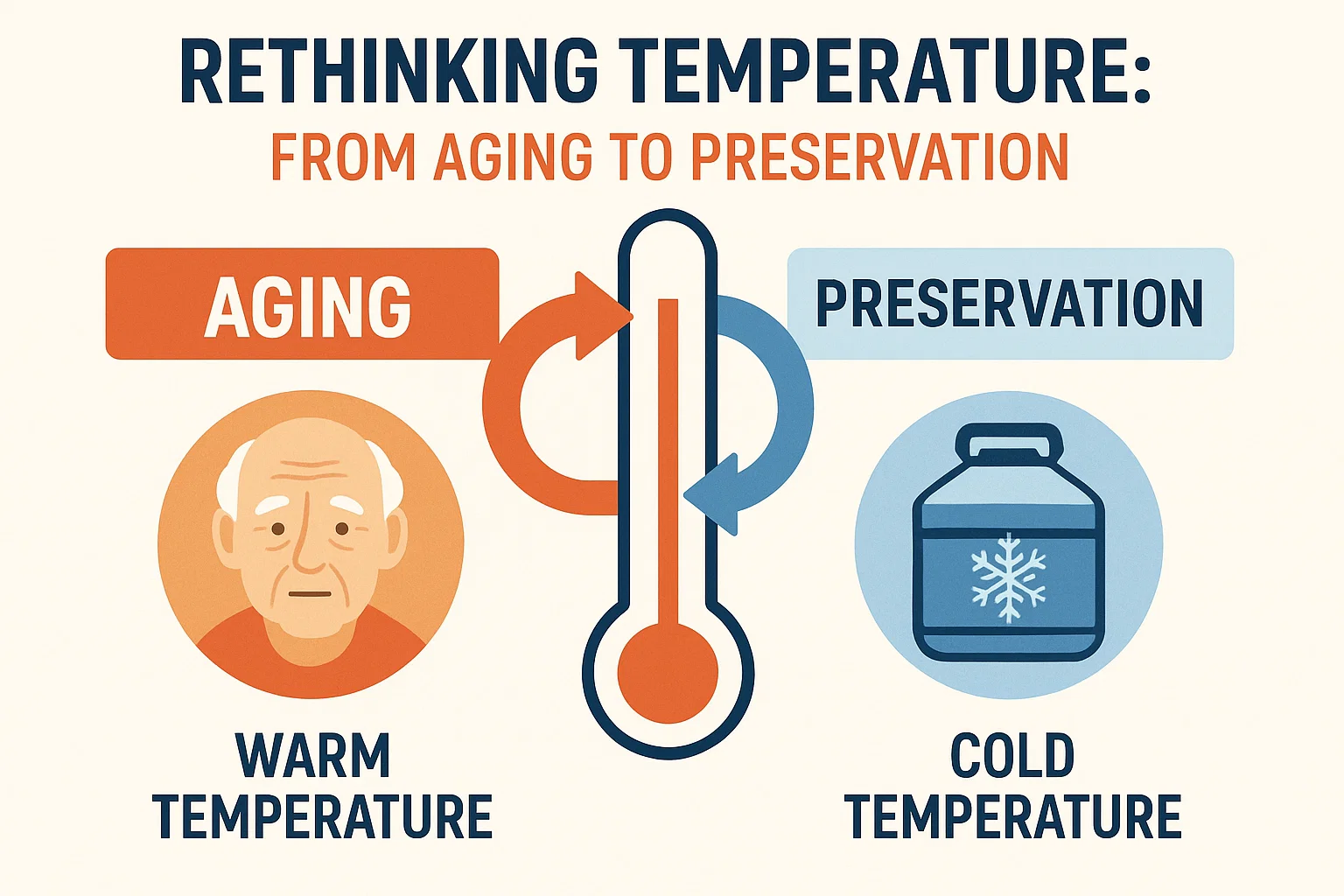Traditionally, discussions of life extension and cryopreservation have run on parallel tracks, one focused on slowing biological wear, the other on arresting it entirely. Emerging research now bridges these views, showing that the same thermal principles that decelerate aging can enhance the success of long-term preservation. By understanding how a cooler internal environment reduces molecular damage and improves vitrification, we gain new perspectives on extending both active lifespan and “pause” lifespan.

How cooling slows molecular wear
Every cellular process, from protein folding to DNA repair, speeds up with heat. Even a 0.5 °C drop in core warmth can tip the balance toward maintenance over turnover:
Reduced oxidative stress: Cooler mitochondria generate fewer reactive oxygen species, sparing lipids, proteins, and nucleic acids from damage.
Enhanced autophagy: Lower warmth shifts nutrient-sensing pathways (mTOR down, AMPK up), promoting cleanup of dysfunctional mitochondria and misfolded proteins.
Stabilized proteostasis: Heat shock proteins work more efficiently when not overtaxed, preventing toxic aggregates from accumulating.
These same mechanisms underlie the improved structural integrity observed when tissues are cooled for cryopreservation, slower reaction rates translate to less chemical degradation during the critical cooling window.
Vitrification: The gold standard of Cryopreservation
True cryopreservation relies on vitrification, a process that replaces bodily fluids with cryoprotectants and cools tissues so rapidly they solidify into a glass-like state - avoiding ice crystals that would otherwise tear cell membranes and disrupt neural circuits. Understanding the nuances of vitrification is key to appreciating why precise thermal control matters. It is also important to understand the differences between science fiction and real-world protocols, separating sci-fi from real science, while getting to know detailed steps, from standby through gradual cooling to –196 °C.
Lessons from nature: Cooling across species
Animal models vividly illustrate how temperature shapes both aging and preservation potential:
Invertebrates: Fruit flies and nematodes exhibit 20–40 percent lifespan extensions when habitat temperature drops by just a few degrees.
Fish and amphibians: Cooler tanks slow metabolic rate and delay senescence markers in zebrafish and frogs.
Mammals: Mice engineered for a lower set-point of core warmth live longer, retain cognitive agility, and tolerate stabilization for cryoprotectant perfusion with fewer cellular lesions.
These findings underscore an evolutionarily conserved thermal-aging link, and suggest that organisms evolved to withstand extended cold may also offer blueprints for improved human cryopreservation.
Optimizing thermal management in practice
To leverage cooling benefits for both daily healthspan and cryopreservation readiness, consider a dual-focused approach:
Controlled ambient climate: Maintain living spaces at a comfortable cool (20–22 °C) to minimize chronic metabolic load and prime tissues for rapid cooling protocols.
Sleep-stage temperature dips: A bedroom around 18 °C helps the body’s natural nocturnal drop in core warmth, supporting restorative sleep and reducing protein aggregation—a plus for preservation quality.
Thermal transition readiness: Brief cold-exposure routines (e.g., 2–3 minute cool showers) can precondition blood flow and cellular stress responses, improving cryoprotectant penetration and uniform cooling.
Mindful nutrition and hydration: Cooler meals and drinks help avoid transient heat spikes, while adequate fluids support circulatory efficiency during both daily function and cryoprotective perfusion.
Integrating emerging technologies
Advances in temperature-sensing wearables now allow continuous monitoring of real-time thermal fluctuations, enabling personalized optimization of core warmth. Combined with AI-driven climate control systems, such tools could one day orchestrate micro-adjustments in ambient and body temperature, maximizing both longevity pathways and cryopreservation outcomes.
In parallel, developments in nanofluidic cryoprotectants and ultra-rapid cooling hardware aim to reduce thermal gradients during vitrification, further safeguarding delicate neural structures. These innovations promise to narrow the gap between laboratory breakthroughs and accessible human protocols.
Empathy and opportunity for those facing terminal illness
Confronting the reality of a terminal prognosis is profoundly challenging. We recognize the emotional weight of these moments, the fears for what lies ahead and the desire to preserve identity and memory. Cryopreservation is not a cure; it is an opportunity to safeguard the intricacies of your biology until future technologies may offer renewed hope. If you’re navigating this path, we’re here to explain the process with compassion, answer every question, and support you in making the choice that aligns with your values and aspirations.
About Tomorrow.bio
At Tomorrow.bio we are dedicated to advancing the science of cryopreservation with the goal of giving people a second chance at life As Europe’s leading human cryopreservation provider we focus on rapid high-quality standby, stabilization and storage of terminal patients preserving them until future technologies may allow revival and treatment.
Our mission is to make human cryopreservation a reliable and accessible option for everyone We believe that no life should end because current capabilities fall short.
Our vision is a future where death is optional where people have the freedom to choose long-term preservation in the face of terminal illness or fatal injury and to awaken when science has caught upInterested in learning more or becoming a member
📧 Contact us at hello@tomorrow.bio
🌐 Visit our website www.tomorrow.bio
🤝 Schedule a call with our team Book a consultation



